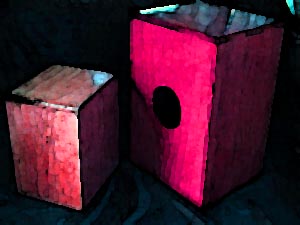 The
Cajon Page The
Cajon Page
Cajon is gaining in popularity very quickly, across the spectrum
of styles, and for good reason; they have a wide and useful variety
of tones, are sturdy, portable, and often double as a stool.
The cajon has primarily Peruvian origins,
but has also taken root in Cuba, where there has long been a tradition
of sitting on the docks playing packing crates. The Cuban
Rumba Yambú is traditionally played on cajon rather than
conga. Peru has it's own tradition, (listen)
and Flamenco music also now uses the Cajon. Flamenco players traditionally
played the backs of their guitars on occasion, and cajon can easily
be seen as growing from this concept.
Some cajons feature panels which are screwed on, with the corners
left loose, to facilitate better and easier slaps. Flamenco cajones
sometimes have strings, actual guitar strings, on the inside,
to make a resonating sound, not unlike a snare.
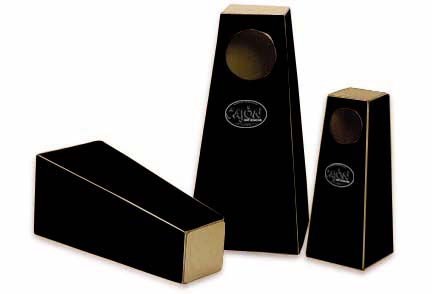 Folks
at Fat
Congas have been making cajones much longer than most
companies. Folks
at Fat
Congas have been making cajones much longer than most
companies.
They make wonderful instruments; we currently own a set of
their Cuban style cajones.
They are also the inventors of the original Batajon®,
a hybrid Bata-Cajon which has influenced other cajon makers
a great deal.
Coming Soon: a review of the
Fat Congas Batajones
& String Cajon |
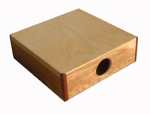 Nowadays
folks everywhere are experimenting with the wood ideophone idea,
and new variations are appearing left and right. One very practical
variation is the lapdrum, extremely portable and rich in tone. Read
Rhythmweb's review of the Lapdrum
from Slapdrum . Chris Nissen at Slapdrum has also made
a full sized cajon that fits across the lap. known as the Slapboxx. Nowadays
folks everywhere are experimenting with the wood ideophone idea,
and new variations are appearing left and right. One very practical
variation is the lapdrum, extremely portable and rich in tone. Read
Rhythmweb's review of the Lapdrum
from Slapdrum . Chris Nissen at Slapdrum has also made
a full sized cajon that fits across the lap. known as the Slapboxx.
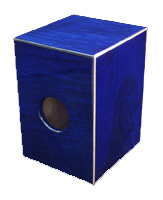 This
dude, Michael Kotzen, makes what may be the most beautiful
custom instruments I've seen;this gorgeous blue one at left is only
the tip of the iceberg. check out his gallery, at www.tonecajon.com
. This
dude, Michael Kotzen, makes what may be the most beautiful
custom instruments I've seen;this gorgeous blue one at left is only
the tip of the iceberg. check out his gallery, at www.tonecajon.com
.
POPercussion
also makes fine cajones.
Sol makes cajones
in the shape of congas.
Sela
instruments designed and built by Marc West
Drum
Warriors makes cajones..
The cajon has also taken off in Japan. Japanese
cajon maker Yoshiro Aonuma
has produced over 1500 instruments, and one of his cajones was played
in the soundtrack of the movie "finding Nemo"by LA musician
Michael G Fisher, who met him on E-Bay! Check out Yoshiro's site
in Japanese
or in English
A nice page in German, and some very pretty instruments
here at Sela
Instruments
Another page in German:
www.tres-lados.com
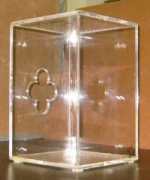 At
left: a new experimental plexiglass cajon, being developed by Chino
Bolanos and LP; Chino is one of the notable Peruvian folkloric artists
at work today. At
left: a new experimental plexiglass cajon, being developed by Chino
Bolanos and LP; Chino is one of the notable Peruvian folkloric artists
at work today.
see more about the Plexicajon and Chino Bolanos
this is an evolving page; more is coming. If you have a
Cajon related site, or want to post an article or lesson concerning
cajon, please
let us know.
|

